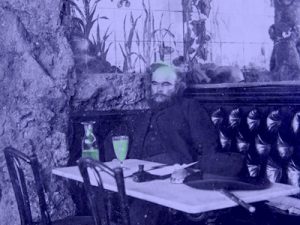
John Osborne, the subject of a new biography by John Heilpern, has never been a household name on my side of the Atlantic Ocean. But they knew him well in England in the 1950’s, when he and Kingsley Amis (father of our Martin) and Harold Pinter and many others bandied around London as The Angry Young Men, a close match to the Beat Generation writers in America, as well as the cafe-haunting Existentialists of Paris. But the fad of the Angry Young Men of London quickly fizzled out, and John Osborne’s subsequent career deserves to be considered on its own terms.
His signature work is Look Back in Anger, which opened in 1956 and gave the “Angry Young Men” their name. It’s the story of a fuming, flannel-shirt wearing London bloke named Jimmy who slaves away at a candy stand all day and plays hot trad jazz saxophone all night. He’s married to a lively young woman, but he’s too brutal and impulsive to keep her love or, ultimately, her respect. Which is okay with him, because he’s more interested in her prim, conceited best friend, who drives him crazy much the same way Blanche DuBois drove Stanley Kowalski crazy in A Streetcar Named Desire. In fact, the film version of this play shows Richard Burton at his most Brando-esque as the rambunctious Jimmy (it also features Claire Bloom, Philip Roth’s future wife, ex-wife and harshest critic as Jimmy’s romantic nemesis, Helena Charles).
Unlike some of his Beat Generation counterparts in America, John Osbourne chose not to continue to milk the “crazy youth” image, but instead turned to the story of an aging, sad music hall singer for his next hit play, The Entertainer. This can be enjoyed in a canonical film version starring Joan Plowright and the great Laurence Olivier, who turns this movie into such a deeply personal statement that many viewers will forget John Osborne (or anybody other than Laurence Olivier) had anything to do with it.
Osborne withdrew further from modern times with his next big success, Luther, a biographical study of the German founder of Protestant Christianity, which opened in London in 1961. Osborne clearly related to the iconoclastic Martin Luther, whose boiling sense of permanent rage recalls the cruel saxophone-wielding Jimmy of Look Back in Anger. (Luther can also be enjoyed in a good 1973 film starring Stacy Keach).
Unfortunately, in his private life John Osborne all too frequently resembled the growling mad, self-pitying male heroes who graced his most successful plays. John Osborne’s literary career was a proud one, but those who know him well speak of a personality marred by fame, self-doubt and selfish impulsiveness.
John Osborne died in 1994. He was married five times, and was said to have had a cruel and terrible relationship with his daughter. In his personal decline, the angry Brit does resemble his flannel-shirt wearing American counterpart, Jack Kerouac. Neither were ready for the ravages of literary fame.




4 Responses
Sounds like Osborne wasn’t a
Sounds like Osborne wasn’t a very nice fellow; which isn’t to say I’m any better, but I don’t blame it on the ravages of obscurity. But you’ve got me thinking. If there were angry young people in London, Paris, New York; there must have been a weltgeist at this time. An intriguing phenomenon that would have been felt in other parts of the world too, like Japan, India, and Turkey.
I think this is true. Why
I think this is true. Why did these fads/movements happen in the 50’s? Well, I can think of two major cultural forces … the fallout from World War II (and the beginning of the atomic-charged Cold War), and the vast changes wrought by technical innovations like television, radio, airplane travel.
If people weren’t angry in the 1950’s, I’d say there was something wrong with them.
Sillitoe…?Frankly (and
Sillitoe…?
Frankly (and shamefully), I’ve never read Osborne, Amis or Pinter–however, I have seen the film versions of some of their works, and I’ve seen Pinter himself act in various pictures. What I found rather surprising is the fact that you never made mention of Alan Sillitoe–the ultimate angry-young-man author, as far as I’m concerned. Saturday Night & Sunday Morning, The Loneliness of The Long-distance Runner, The Ragman’s Daughter–his is the ultimate canon of young Brit anger in the ’50s and ’60s.
As for Angry Young Man lit and culture dissipating after the ’50s, the fact of the matter is that a large portion of it was swallowed up by the burgeoning Mod, ‘swinging London’ and British rock culture of the 1960s. The Who alone owe a hell of a lot to the angry young men–particularly Sillitoe. Check out Wicked Uncle Ernie from the Tommy rock opera and tell me he wasn’t inspired by the title character from Sillitoe’s short story ‘Uncle Ernest’ (from Long-distance Runner). The Pink Floyd–especially Waters–also owe a lot to the angry young men, as far as I’m concerned, as do Black Sabbath, The Sex Pistols, The Jam, Iron Maiden, etc.
Then again, Leonard Cohen, Dylan, Zappa & The Mothers, The Doors, The Velvet Underground, Grateful Dead, The Stooges, etc. owe a hell of a lot to the beats, too, don’t they…?
As a Who fan, especially the
As a Who fan, especially the early Who, I am definitely going to check out some of Sillitoe’s work.